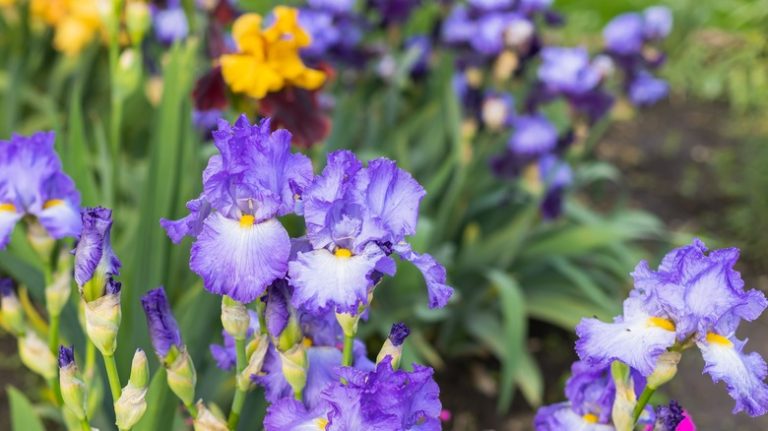Grape hyacinths, also known as muscari, are a popular spring-blooming bulb variety that is commonly found in gardens. These small bulbs are called “grape” because of their unique shape that resembles a cluster of grapes. They come in different colors, but the most common ones are the blue and white varieties.
When it comes to caring for grape hyacinth bulbs, it is important to start by planting them in the right location. They prefer well-drained soil and thrive in zones 4 to 8. These bulbs can be planted outdoors in the fall, just like daffodils and tulips. If you want to enjoy their blooms indoors, you can also start them in pots and then transfer them outside when the danger of frost has passed.
Grape hyacinths are quite easy to care for. They require minimal watering, especially during their dormant period in winter. Once they start to bloom, a light watering is enough to keep them happy. It is important to also provide them with enough sunlight, as they need at least 6 hours of direct sunlight per day.
After the blooms have faded, you can let the foliage die back naturally. This allows the bulbs to store energy for the next season. If you want a more neat and organized look, you can also carefully remove the foliage once it has turned yellow. However, be careful not to damage the bulb itself.
In terms of division and repotting, grape hyacinth bulbs can be left undisturbed for several years. However, if they become too crowded, it is best to divide them in early fall. This can be done by gently digging up the bulbs, separating the smaller ones from the larger ones, and then replanting them in well-prepared soil.
Grape hyacinth bulbs are a great addition to any garden, as they provide a beautiful splash of color in the early spring. Whether you choose the blue ‘Blue Finnis’ variety or the white ‘Valerie Finnis’ variety, these bulbs will surely enhance the overall aesthetic of your garden. So why not give them a try and enjoy their beauty year after year?
How to Plant and Grow Grape Hyacinth
Grape hyacinths, also known as muscari, are charming spring-flowering bulbs that are easy to grow and care for. With their unique grape-like blooms and delightful fragrance, they are a popular choice for gardens and landscapes.
Planting Grape Hyacinth Bulbs
If you want to enjoy the beauty of grape hyacinths in your garden, here’s how to plant them:
- Choose a Suitable Location: Grape hyacinths thrive in well-drained soil and are best planted in full sun to light shade. They can be planted in borders, rock gardens, or even in containers.
- Prepare the Soil: Prior to planting, make sure to amend the soil with organic matter to improve drainage and fertility.
- Plant the Bulbs: Dig holes about 4-6 inches deep and space the bulbs about 3-4 inches apart. Place the bulbs with the pointed end facing up and cover them with soil. Water them well after planting.
- Provide Adequate Water: Grape hyacinths like slightly moist soil, but be careful not to overwater, as they don’t tolerate soggy soil.
- Care and Maintenance: Grape hyacinths are generally carefree and don’t require much attention. However, removing faded flowers and leaves after blooming can help to keep the plant neat and prevent it from self-seeding excessively.
Propagating Grape Hyacinths
If you want to propagate grape hyacinths, there are a few methods you can try:
- Division: After several years, clumps of grape hyacinth bulbs may become crowded. In late spring or early summer, lift the bulbs and separate them into smaller sections, making sure each section has a few bulbs and roots.
- Seeds: Grape hyacinths can also be grown from seeds. Collect the seeds after the flowers have faded and sow them in a well-prepared seedbed. Keep the soil consistently moist, and the seeds will germinate in approximately 3-4 weeks.
Common Problems and Pests
Grape hyacinths are relatively pest and disease-free. However, there are a few common problems you may encounter:
- Pests: Snails and slugs may feed on the foliage of grape hyacinths. Applying organic pest control methods can help to deter these pests.
- Humidity: High humidity can lead to fungal diseases, such as botrytis. To prevent this, make sure to provide good air circulation and avoid overcrowding the plants.
- Warning: Some gardeners may find that grape hyacinths have a tendency to naturalize and spread quickly. If you want to contain their growth, consider planting them in containers or regularly removing the bulbs from unwanted areas.
Now that you know how to plant and care for grape hyacinth, why not add these lovely bulbs to your garden? They will bring a touch of elegance and beauty to your outdoor space, and you can enjoy their charming blooms each spring.
Grape Hyacinth Overview
Grape hyacinth, scientifically known as Muscari, is a popular spring-blooming bulb that belongs to the Lily family. This plant is native to Southern Europe and is widely cultivated in gardens around the world for its colorful and fragrant flowers.
Grape hyacinths are named for their clusters of small, bell-shaped flowers that resemble tiny grapes. These flowers come in various shades of blue, purple, and white, and are often used in floral arrangements or as a groundcover in gardens.
The foliage of grape hyacinth consists of long, slender leaves that emerge from the bulbs in early spring. The leaves are slightly broader than those of daffodils and can be slightly waxy to the touch. The bulbs themselves are small and round, typically about 1-2 centimeters in diameter.
Grape hyacinths are easy to grow and care for. They prefer well-draining soil and are often planted in the fall, before the first frost. The ideal temperature for grape hyacinths is around 60-70 degrees Fahrenheit (15-21 degrees Celsius). They require regular watering, especially during the growing season, but be careful not to overwater as this can lead to root rot.
Grape hyacinths can be grown both indoors and outdoors. Indoors, they can be forced to bloom earlier by providing them with cooler temperatures and darkness for a period of time before bringing them into a warmer, brightly lit area.
To propagate grape hyacinths, they can be divided every 3-4 years, after the foliage has died back. The bulbs can be carefully dug up and separated into smaller clusters, making sure to keep some foliage attached to each division.
The common diseases and pests that can affect grape hyacinths include bulb rot, mosaic virus, and pests like aphids and slugs. To prevent diseases, it is best to plant grape hyacinth bulbs in well-draining soil and avoid overwatering. Regularly inspect the plants for any signs of diseases or pests and take necessary action to control them.
| Planting | Watering | Light | Temperature | Fertilizer |
|---|---|---|---|---|
| Plant bulbs in the fall before the first frost | Regular watering, but avoid overwatering | Full sun to partial shade | Ideal temperature around 60-70°F (15-21°C) | Apply a slow-release bulb fertilizer in spring and fall |
In conclusion, grape hyacinths are beautiful and easy to grow spring-blooming bulbs that add a colorful touch to gardens. With their vibrant flowers and attractive foliage, they are a popular choice for both experienced gardeners and beginners. If you have any questions about grape hyacinth care or growing, don’t hesitate to ask your local garden shop or seek advice from reliable online sources.
Where to Plant Grape Hyacinth
Grape hyacinths, also known as Muscari, are beautiful spring-flowering bulbs that look like tiny bunches of grapes. They are easy to grow and can add a pop of color to any garden or landscape. Here’s a guide on where to plant grape hyacinth bulbs:
1. Soil: Grape hyacinths thrive in well-drained soil that is slightly acidic. They prefer soil that is rich in organic matter and can hold moisture without becoming waterlogged.
2. Light: Grape hyacinths like full sun or light shade. They will tolerate partial shade, but may not produce as many flowers.
3. Temperature: Grape hyacinths are hardy in USDA hardiness zones 3 to 9. They can tolerate cold winter temperatures and even a light frost. However, they may not perform well in hotter climates.
4. Watering: Grape hyacinths are drought-tolerant once established, but they will benefit from regular watering during the growing season. Water them sparingly during winter months.
5. Planting: Grape hyacinth bulbs should be planted in the fall, before the first frost. Plant them about 2 to 4 inches apart and 2 to 4 inches deep. They can be planted in clusters or in rows for a more cohesive look.
6. Mulch: Mulching around grape hyacinth plants will help to retain moisture and suppress weed growth. Use an organic mulch, such as wood chips or straw, to create a protective layer around the bulbs.
7. Pests and Diseases: Grape hyacinths are generally pest and disease-free. They are resistant to deer and other animals that may browse on your garden plants.
8. Maintenance: Grape hyacinths are low-maintenance plants. After flowering, allow the foliage to die back naturally before removing it. This will allow the bulbs to store up energy for the next growing season.
9. Dividing: Over time, grape hyacinth bulbs will multiply and form clumps. To maintain healthy plants and encourage continued blooming, divide the bulbs every 3 to 4 years. This can be done in early fall or late spring.
10. Companion Plants: Grape hyacinths look great when planted alongside other spring bulbs, such as tulips and daffodils. Their small size and unique color will complement larger flowers and create a stunning display.
If you have any questions or need further information about growing grape hyacinths, contact your local garden center or consult with experienced gardeners. They can provide more specific advice based on your area’s climate and growing conditions. Happy gardening!
How and When to Plant Grape Hyacinth
Planting grape hyacinth bulbs is a great way to add a pop of color to your garden in the spring. These beautiful flowers, also known by their scientific name Muscari, are easy to grow and require minimal care. Here are some tips on how and when to plant grape hyacinth bulbs:
- Choosing the right bulbs: Grape hyacinth bulbs are commonly available at garden shops and online. There are different types and varieties of grape hyacinth, including the popular blue muscari. You can also find white, pink, and even broad-leaved latifolium varieties. Choose bulbs that are firm and free from damage or mold.
- Planting time: Grape hyacinth bulbs should be planted in the fall, before the first frost. This gives them enough time to establish their roots before winter sets in. You can also plant them in early spring, but they may not bloom as lushly in their first year.
- Planting location: Grape hyacinths prefer well-draining soil and full to partial sun. They can tolerate a wide range of soil types, but they grow best in soil that is slightly acidic to neutral. Choose a spot in your garden that gets at least six hours of sunlight per day.
- Planting process: Dig a hole that is two to three times the depth of the bulb and space the bulbs 3-4 inches apart. Place the bulb in the hole with the pointed end facing up, and cover it with soil. Water the area thoroughly after planting to help settle the soil.
- Caring for grape hyacinth: Grape hyacinth bulbs require minimal care once planted. They are fairly drought-tolerant, so you only need to water them if there is an extended period of dry weather. To promote healthy growth, you can fertilize the bulbs with a balanced fertilizer once a year in early spring. Remove any dead foliage after it withers away.
- Propagation: Grape hyacinths can be propagated by division or from seeds. Division is the easiest method and should be done in autumn when the foliage has died back. Dig up the bulbs and gently separate the offsets, then replant them in a new location. If you want to grow grape hyacinths from seed, collect the seeds after the flowers have finished blooming and sow them in pots or directly in the garden.
- Common problems: Grape hyacinths are generally resistant to pests and diseases, but they can sometimes be affected by aphids or bulb rot. To prevent aphids, you can hose down the plants with water or use insecticidal soap. Bulb rot is often caused by excessive moisture, so make sure the soil has good drainage.
- Forcing indoors: If you want to enjoy grape hyacinths earlier in the year, you can force the bulbs to bloom indoors. Place the bulbs in a potting mix and keep them in a cool, dark place for several weeks. Then, move the pot to a brighter location and water regularly. The bulbs will start to grow and bloom, bringing a touch of spring indoors.
- Hardiness zone: Grape hyacinths are hardy in USDA zones 4-9. Check your local hardiness zone to determine if this plant is suitable for your area.
By following these tips, you can experience the joy of growing grape hyacinths in your garden. Their unique flowers and harmonious colors will surely brighten up your spring!




